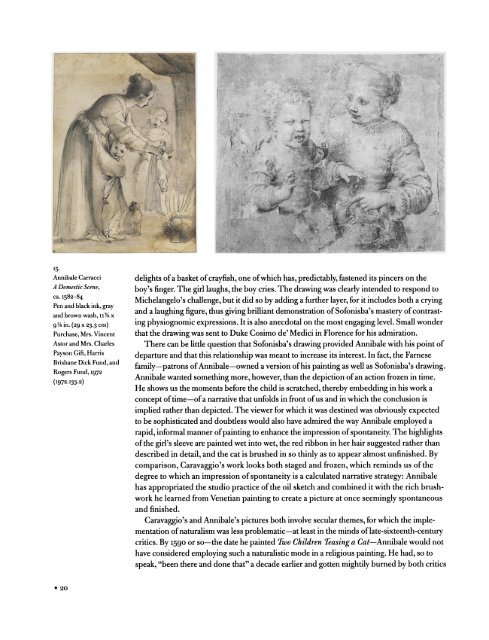GOING FOR BAROQUE Into the Bin - The Metropolitan Museum of Art
GOING FOR BAROQUE Into the Bin - The Metropolitan Museum of Art
GOING FOR BAROQUE Into the Bin - The Metropolitan Museum of Art
You also want an ePaper? Increase the reach of your titles
YUMPU automatically turns print PDFs into web optimized ePapers that Google loves.
15<br />
Annibale Carracci<br />
A Domestic Scene,<br />
ca. 1582-84<br />
Pen and black ink, gray<br />
and brown wash, 11% x<br />
9'/sin. (29x23.3 cm)<br />
Purchase, Mrs. Vincent<br />
Astor and Mrs. Charles<br />
Payson Gift, Harris<br />
Brisbane Dick Fund, and<br />
Rogers Fund, 1972<br />
(1972.133.2)<br />
delights<br />
<strong>of</strong> a basket <strong>of</strong> crayfish,<br />
one <strong>of</strong> which has, predictably,<br />
fastened its pincers<br />
on <strong>the</strong><br />
boy's finger. <strong>The</strong> girl laughs,<br />
<strong>the</strong> boy<br />
cries. <strong>The</strong><br />
drawing<br />
was<br />
clearly<br />
intended to respond<br />
to<br />
Michelangelo's challenge,<br />
but it did so by adding<br />
a fur<strong>the</strong>r<br />
layer,<br />
for it includes both a crying<br />
and a laughing figure,<br />
thus giving<br />
brilliant demonstration <strong>of</strong> S<strong>of</strong>onisba's mastery <strong>of</strong> contrast<br />
ing physiognomic expressions.<br />
It is also anecdotal on <strong>the</strong> most<br />
engaging<br />
level. Small wonder<br />
that <strong>the</strong> was drawing<br />
sent to Duke Cosimo de' Medici in Florence for his admiration.<br />
<strong>The</strong>re can be little question<br />
that S<strong>of</strong>onisba's<br />
drawing provided<br />
Annibale with his point<br />
<strong>of</strong><br />
departure<br />
and that this relationship<br />
was meant to increase its interest. In fact, <strong>the</strong> Farnese<br />
family?patrons<br />
<strong>of</strong> Annibale?owned a version <strong>of</strong> his painting<br />
as well as S<strong>of</strong>onisba's<br />
drawing.<br />
Annibale wanted<br />
something more, however, than <strong>the</strong> depiction<br />
<strong>of</strong> an action frozen in time.<br />
He shows us <strong>the</strong> moments before <strong>the</strong> child is scratched, <strong>the</strong>reby embedding<br />
in his work a<br />
concept <strong>of</strong> time?<strong>of</strong> a narrative that unfolds in front <strong>of</strong> us and in which <strong>the</strong> conclusion is<br />
implied<br />
ra<strong>the</strong>r than depicted.<br />
<strong>The</strong> viewer for which it was destined was<br />
obviously expected<br />
to be sophisticated<br />
and doubtless would also have admired <strong>the</strong> way Annibale<br />
employed<br />
a<br />
rapid, informal manner <strong>of</strong> painting<br />
to enhance <strong>the</strong> impression<br />
<strong>of</strong> spontaneity.<br />
<strong>The</strong><br />
highlights<br />
<strong>of</strong> <strong>the</strong> girl's<br />
sleeve are painted<br />
wet into wet, <strong>the</strong> red ribbon in her hair<br />
suggested<br />
ra<strong>the</strong>r than<br />
described in detail, and <strong>the</strong> cat is brushed in so as thinly<br />
to appear almost unfinished.<br />
By<br />
comparison, Caravaggio's<br />
work looks both<br />
staged<br />
and frozen, which reminds us <strong>of</strong> <strong>the</strong><br />
degree<br />
to which an impression<br />
<strong>of</strong> spontaneity<br />
is a calculated narrative strategy: Annibale<br />
has<br />
appropriated<br />
<strong>the</strong> studio practice<br />
<strong>of</strong> <strong>the</strong> oil sketch and combined it with <strong>the</strong> rich brush<br />
work he learned from Venetian<br />
painting<br />
to create a picture<br />
at once<br />
seemingly spontaneous<br />
and finished.<br />
Caravaggio's<br />
and Annibale's pictures<br />
both involve secular <strong>the</strong>mes, for which <strong>the</strong> imple<br />
mentation <strong>of</strong> naturalism was less problematic?at<br />
least in <strong>the</strong> minds <strong>of</strong> late-sixteenth-century<br />
critics.<br />
By 1590 or so?<strong>the</strong> date he painted<br />
Two Children<br />
Teasing<br />
a Cat?Annibale would not<br />
have considered<br />
employing<br />
such a naturalistic mode in a religious painting.<br />
He had, so to<br />
speak,<br />
"been <strong>the</strong>re and done that" a decade earlier and gotten mightily<br />
burned<br />
by<br />
both critics<br />
20
















